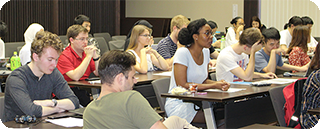研究成果 Research Results
- TOP
- News
- Research Results
- As global warming worsens, so may space communications
As global warming worsens, so may space communications
Higher CO₂ concentrations in the atmosphere increase the strength of sporadic-E and lower the altitude at which it occursProfessor Huixin Liu
Faculty of Sciences
2025.10.27Research ResultsPhysics & ChemistryEnvironment & Sustainability
Fukuoka, Japan—Researchers at Kyushu University have found that rising CO₂ levels in our atmosphere could lead to future disruptions in shortwave radio communications, including systems used for air traffic control, maritime communication, and radio broadcasting.
While we know that increasing CO₂ levels in our atmosphere causes global warming at Earth's surface, something different is happening in the ionosphere located 100 km above sea level. Up there, it’s cooling.
“This cooling doesn’t mean it is all good. It decreases the air density in the ionosphere and accelerates wind circulation,” explains Professor Huixin Liu of Kyushu University’s Faculty of Science, who led the study published in Geophysical Research Letters. “These changes affect the orbits and lifespan of satellites and space debris and also disrupt radio communications through localized small-scale plasma irregularities.”
One such irregularity is known as ‘sporadic-E' or ‘Es,’ a phenomenon where a dense layer of metal ions forms at an altitude of 90 to 120 km.
“As the name suggests, Es are sporadic and difficult to predict. However, when they occur, they can disrupt HF and VHF radio communications,” continues Liu. “Our results revealed that, at high CO₂ levels, Es tend to become stronger, occur at lower altitudes, and persist longer at night.”
Using a whole-atmosphere model, Liu and her team developed simulations of the upper atmosphere under two different CO₂ concentrations: at normal concentrations of 315 ppm, and then at 667 ppm (the average atmospheric CO₂ level in 2024 was 422.8 ppm). They then evaluated changes in vertical ion convergence (VIC), which drives Es.
Their simulations revealed that, at higher atmospheric CO₂ levels, VIC is enhanced globally at altitudes of 100-120 km; the Es hotspots shift downward by approximately 5 km; and their diurnal patterns change. Further investigation revealed that these changes were caused by lower atmospheric density and wind disturbances.
“These findings are the first of its kind to show how increasing CO₂ affects the occurrence of Es, revealing new insight into cross-scale coupling processes between neutral air and ionosphere plasma. In other words, they show how global climate-driven changes can impact small-scale plasma phenomena in space,” explains Liu. “Considering our findings, the telecommunications industry will need to develop a long-term vision that accounts for the impacts of global warming and climate change in their future operations. Global warming affects not just the Earth but extends well into space.”
Fig. 1. Radio waves in the ionosphere. Photo of the Earth with radio waves, depicted in purple, flowing across it. HF and VHF waves travel through the ionosphere. But a phenomenon called sporadic-E can interfere with these frequencies. Researchers found that as CO₂ levels in our atmosphere rise, sporadic-E may become stronger, occur at lower altitudes, and persist longer at night. (Huixin Liu/Kyushu University)
###
For more information about this research, see "How does increasing CO₂ concentration affect the ionospheric Sporadic-E formation?" Farhan Naufal Rifqi, Huixin Liu, Lihui Qiu, Chihiro Tao, Hiroyuki Shinagawa Geophysical Research Letters, https://doi.org/10.1029/2025GL117911
Research-related inquiries
Huixin Liu,Professor
Faculty of Science
Contact information can also be found in the full release.
- TOP
- News
- Research Results
- As global warming worsens, so may space communications































